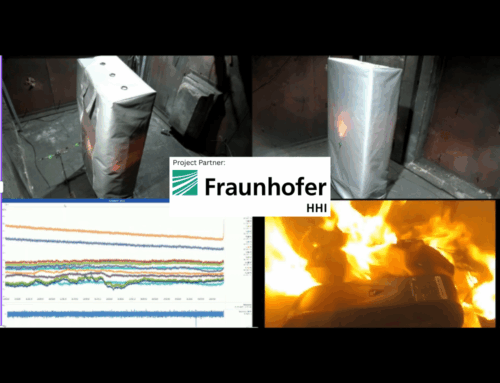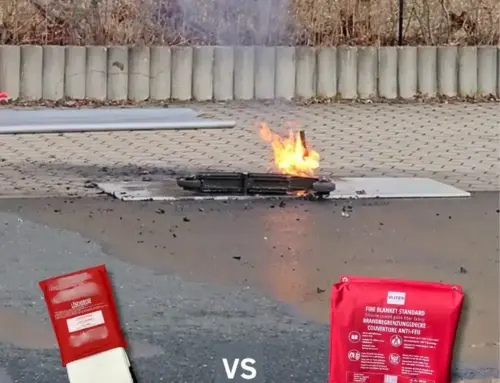
Lithium-ion batteries have revolutionized our daily lives and have become an integral part of modern technology. They power electric cars, e-bikes, smartphones and a variety of other devices. However, their high energy density makes them a significant challenge for fire departments in the event of a fire. This document serves as a detailed guide to understanding the special features of battery fires and the correct first steps to take in an emergency. It also shows how modern tools such as fire blankets can increase the safety and efficiency of the emergency services.
Table of contents
Special features of battery fires
Thermal Runaway
Lithium-ion batteries can enter a so-called thermal runaway due to mechanical damage, overcharging or an internal defect. One cell ignites and triggers a chain reaction that affects neighboring cells. This process can reach temperatures of up to 1,300 °C, which pushes conventional extinguishing methods to their limits.
Oxygen-independent fires
In contrast to conventional fires, lithium-ion batteries already contain the necessary components for combustion - anode, cathode and electrolyte - inside them. This means that the fire can continue without an external supply of oxygen.
Re-inflammation
Even after a seemingly successful extinguishing of a battery fire, there is a risk of re-ignition. This can happen hours or even days later and requires special care when re-securing.
Toxic gases
When a lithium-ion battery burns, toxic fumes such as hydrogen fluoride and carbon monoxide are produced. These not only pose an acute danger to the emergency services, but also have considerable environmental consequences.
First steps in the event of a battery fire
1. assess the situation
- Identify the source of the fire: Determine whether the fire is coming directly from the battery or from surrounding objects.
- Risk assessment: Watch out for possible explosions caused by bursting battery cells that may fly around.
2. secure and evacuate
- Cordon off the danger zone: Evacuate the surrounding area generously to protect people from smoke, heat and flying debris.
- Set up safety zones: Cordon off the fire scene to prevent unauthorized access.
3. reduce heat.
- Use of fire blankets: Products such as the VLITEX E-AUTO effectively insulate the heat and reduce the risk of it spreading further.
4. check smoke and gas development
- Use breathing apparatus: Protect emergency personnel from toxic gases with suitable protective equipment.
- Enclosure of smoke development: fire blankets can help to isolate smoke and gases and thus minimize the environmental impact.
5. re-securing
- Safe storage: Place the affected device or vehicle in a special safety container or cover it with a fire blanket . The Car Service Set is recommended for electric cars.
- Temperature monitoring: Use heat sensors, such as thermal imaging cameras or the Temperature Tracker, to detect potential re-inflammation at an early stage.
Use of modern aids
Fire blankets
fire blankets are a simple but effective method of containing battery fires. They isolate the fire, prevent the flames from spreading and protect the surrounding area. They provide indispensable support, especially in confined spaces such as underground garages or in the case of fires involving electric vehicles.
Find out more about their possible uses in our article on fire blankets for fire departments.
Extinguishing lances
Extinguishing lances make it possible to inject water or extinguishing agents directly into the affected battery cells. This targeted method accelerates the cooling process and reduces the risk of further spread.
Temperature monitoring
After an operation, temperature sensors can be used to monitor the burning material. This is a proactive measure to detect reignition at an early stage and initiate appropriate measures.
Prevention: training and equipment
Good preparation is the best way to act safely and efficiently in an emergency. Fire departments should be regularly trained in the specific requirements of battery fires. This includes
- Theoretical knowledge: Understanding of the chemical and physical properties of lithium-ion batteries.
- Practical exercises: The use of tools such as fire blankets and extinguishing lances should be practiced regularly.
- Safety equipment: Breathing apparatus and suitable protective clothing are essential to ensure the health of the emergency services.
Act efficiently and safely in the event of battery fires
Battery fires present a particular challenge, but one that can be dealt with effectively with the right preparation and equipment. Knowledge, practice and the use of modern tools such as fire blankets can make the difference between a controlled operation and an unmanageable risk. Fire departments that familiarize themselves with these methods are best equipped to act safely and efficiently.









